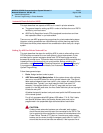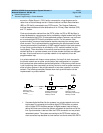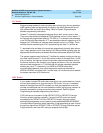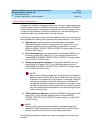
MERLIN LEGEND Communications System Release 6.1
Network Reference
555-661-150
Issue 1
August 1998
Network Management
Page 5-11General Programming in Private Networks
5
■ If the pattern associated with the calling group has a route that includes
PSTN trunks, each call over the PSTN has an associated cost.
■ SMDR records for calls sent across a private network may be different from
what is expected. For example, UDP calling may not be logged for part of
the call. If a call from system A is routed through system B to system C and
system A has SMDR turned on to log UDP calls, system B has SMDR
turned off to log UDP calls and system C has SMDR turned on to log UDP
calls, the call is logged at system A, not at system B and logged at system
C.
■ Calls sent to a calling group with a non-local member will never overflow
locally. The calls are sent across the private network and the exact
processing depends on the nature of the receiving extension on the far
system. As a result, local delay announcement devices, queue alarm,
external alert, and queue control will never be activated for a calling group
with a non-local member.
■ An extension on a MERLIN LEGEND system cannot be a member of a
DEFINITY ECS or DEFINITY ProLogix hunt group.
NOTE:
The DEFINITY ECS “route to” step in vectoring can overflow calls to
a non-local extension on a MERLIN LEGEND. However, no Look
Ahead Interflow is provided and calls are recorded in BCMS and
CSM as an “Outflow” call. For complete details, refer to DEFINITY
ECS documentation.
■ More than one calling group with a non-local member can be assigned on a
system.
■ A calling group with a non-local member cannot have a local member and
a calling group with local members cannot have a non-local member.
■ A non-local number can be a member of more than one calling group.
■ When coverage calls using calling groups are routed across a private
network, an MLX display telephone shows information about the call
origination. It does not indicate that the call is a coverage call as would be
the case for local coverage. Personnel who may receive coverage calls for
non-local extensions should be advised of this difference in displayed
information between local and non-local coverage. The exact information
displayed depends on whether the tandem trunk connecting the systems is
a PRI trunk or a tie trunk as shown below.
Table 5–1. Cross-Network Display Information
Tandem Type Inside Calls Outside Calls
PRI Caller’s Name Caller ID/ANI (as long as not answered)
Tie Trunk Number Trunk Number


















